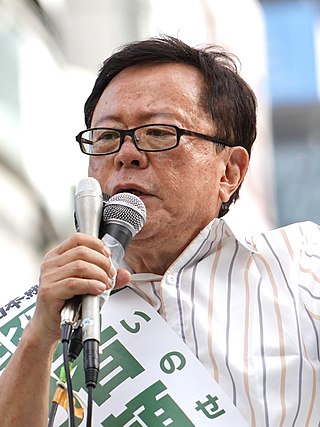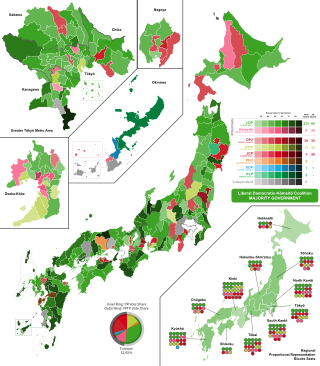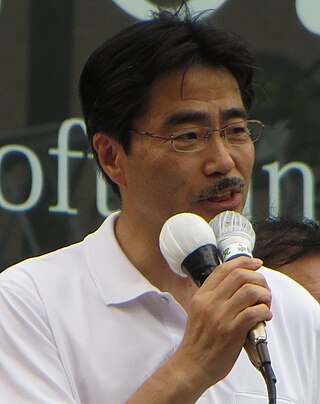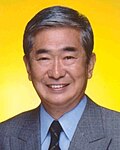
Shigeru Ishiba is a Japanese politician. Ishiba is a member of the Liberal Democratic Party (LDP), and is the leader of the Suigetsukai party faction, and a member of the Heisei Kenkyūkai faction, which was then led by Fukushiro Nukaga, until 2011.

The Japanese political process has two types of elections.

Tarō Yamamoto is a Japanese politician and former actor, who is the founder and current leader of the anti-establishment political party Reiwa Shinsengumi. Yamamoto served as a member of the House of Councillors from 2013 to 2019 for Tokyo, initially as an independent and later as member of the People's Life Party / Liberal Party. He was a candidate in the 2020 Tokyo gubernatorial election, as a member of Reiwa Shinsengumi.

Prefectural elections for the Tokyo Metropolitan Assembly were held on 12 July 2009. In the runup to the Japanese general election due by October they were seen as an important test for Taro Aso's ruling coalition of the Liberal Democratic Party (LDP) and the New Komeito. New Komeito considers Tokyo as an important stronghold and had repeatedly asked Prime Minister Aso to avoid holding the two elections within a month of each other.

The Tokyo 3rd district is a constituency of the House of Representatives in the Diet of Japan. It is located in Tokyo and covers parts of the former city of Tokyo and Tokyo's outlying islands. The district consists of the wards of Shinagawa and parts of Ōta, the towns of Ōshima and Hachijō and the villages of Toshima, Niijima, Kōzushima, Miyake, Mikurajima, Aogashima and Ogasawara. As of 2012, 482,494 eligible voters were registered in the district.

Tokyo 8th district is a single-member constituency of the House of Representatives in the national Diet of Japan. It is located in western part of former Tokyo City and is almost coterminous with Suginami Ward. The district was created in 1994 as part of an electoral reform effort in the Japanese House of Representatives, and was first implemented in the 1996 general election.
The 17th unified local elections in Japan took place in April 2011. In the first phase on April 10, 2011, 12 governors, 41 prefectural assemblies as well as five mayors and 15 assemblies in cities designated by government ordinance were elected. In the second phase on April 24, 2011, mayors and assemblies in hundreds of cities, "special wards" of Tokyo, towns, and villages were up for election. Additionally, a by-election for the National Diet was held in Aichi on April 24.
Events in the year 2012 in Japan.

The 2012 Tokyo gubernatorial election took place on December 16, 2012, which was held on the same day as the general election.

Kenji Utsunomiya is a Japanese lawyer and former chair of the Japan Federation of Bar Associations.

General elections were held in Japan on 14 December 2014. Voting took place in all Representatives constituencies of Japan including proportional blocks to elect the members of the House of Representatives, the lower house of the National Diet of Japan. As the cabinet resigns in the first post-election Diet session after a general House of Representatives election, the lower house election also led to a new election of the prime minister in the Diet, won by incumbent Shinzō Abe, and the appointment of a new cabinet. The voter turnout in this election remains the lowest in Japanese history.

The 2014 Tokyo gubernatorial election took place on February 9, 2014 to replace outgoing Governor Naoki Inose, who resigned effective December 24, 2013. Yōichi Masuzoe was declared the winner in exit polling, with a substantial lead over the fifteen other candidates. His final tally was 2,112,979 votes (42.86%), with his two closest competitors Morihiro Hosokawa and Kenji Utsunomiya failing to break the 20% mark. Total turnout was 4,930,251 (46.14%), significantly lower than the 62.6% turnout in the 2012 election.

Kagoshima 2nd district is a single-member electoral district of the House of Representatives, the lower house of the National Diet of Japan. The district covers two different parts of Kagoshima Prefecture. On the main island of Kyushu, it covers most of the Satsuma Peninsula; this includes the cities of Makurazaki, Ibusuki, Minamisatsuma, and Minamikyūshū, as well as the former municipalities Taniyama City and Kiire Town, which are now a part of the capital Kagoshima City. The district also includes Ōshima Subprefecture, which covers the Amami Islands more than 300 kilometres to the south, which includes the city of Amami. In 2021, the district had 337,660 eligible voters.
The first stage of the 18th unified local elections in Japan took place on April 12, 2015. The Liberal Democratic Party under leadership of Shinzo Abe was the overall victor, winning many races including all ten gubernatorial races and 1,153 of the 2,284 assembly seats at stake. Further elections for municipal mayors and assemblies took place on April 26.

The 2016 Tokyo gubernatorial election took place on 31 July 2016 to elect the successor to Governor Yoichi Masuzoe, who submitted his resignation to the Tokyo Metropolitan Assembly on 15 June 2016. By-elections in four of Tokyo's cities were held on the same day to fill vacancies in the Assembly.

A by-election for the Tokyo 10th district in the Japanese Japanese House of Representatives was held on 23 October 2016 to replace Yuriko Koike, who vacated the seat to contest the Tokyo gubernatorial election in July 2016. Koike, a member of the Liberal Democratic Party (LDP), had represented the district since the December 2012 general election and also served a previous term from 2005 to 2009. The election was won by LDP candidate Masaru Wakasa, an incumbent member for the Tokyo proportional representation block who had supported Koike during her gubernatorial campaign. A separate by-election for the Fukuoka 6th district was held on the same day.

Tokyo 7th district is a constituency of the House of Representatives in the Diet of Japan. The district is in central Tokyo City and encompasses the entire Shibuya ward, parts of Nakano, Shinagawa and Meguro wards as well as a small part of Suginami.

The 2020 Tokyo gubernatorial election took place on 5 July 2020 to elect the Governor of Tokyo. In a result viewed as an endorsement of her handling of Tokyo's response to the COVID-19 pandemic, incumbent Yuriko Koike was re-elected for a second term in a landslide, increasing her share of the vote to 59.7%.

Prefectural elections for the Tokyo Metropolitan Assembly were held on 4 July 2021. The 127 members were elected in forty-two electoral districts, seven returning single members elected by first-past-the-post, and thirty-five returning multiple members under single non-transferable vote. Two districts had their magnitude adjusted in this election to match population changes.
Akimasa Suzuki is a Japanese politician who is the Mayor of Ōta, a Special ward of Tokyo, since April 2023. A former member of the Tokyo Metropolitan Assembly, Suzuki was chairman of the Special Committee on Budget and Chairman of the General Affairs Committee.















